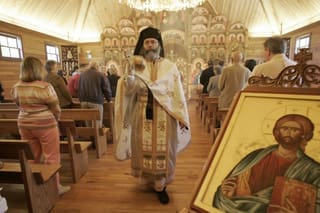An Eastern Slavic people akin to Belarussians, Russians and Ukrainians, the Rusyns — whose homeland lies south of the Carpathian Mountains in the heart of central Europe — have always lived under the governance of another people. They toiled the soil, kept livestock or cut timber, usually as serfs or tenant laborers of their Hungarian, German or Polish masters, landholders who eagerly imposed their identity on their subjects.
An estimated 200,000 Rusyns immigrated to the United States, beginning in the late 19th century, settling in the industrialized areas of Pennsylvania, New York, Ohio, New Jersey, Connecticut, West Virginia and Indiana. Lured by employment agents of the mines and mills, they quarried coal and forged steel, enriching their employers while building a nation. And though working conditions were wretched, many Rusyn immigrants, once married, believed they lacked nothing except a church in which they could worship God in keeping with the traditions of their forebears.
The desire of Rusyn-Americans to maintain their Eastern Christian faith, or stara vira (old faith), and the privileges and rites associated with it, would eventually split the community. Yet this resolve would also hinder its assimilation. The American Carpatho-Russian Orthodox Greek Catholic Church, an eparchy (diocese) of the Ecumenical Patriarchate of Constantinople, echoes this Rusyn-American fidelity to faith and forebears.

Concerned for the erosion of their traditions and identity, after decades of conflict with Roman Catholic ordinaries in the United States, an assembly of priests and laity, led by Father Orestes Chornock (1883-1977), met in Pittsburgh in November 1937. After repealing the union with the bishop of Rome that bound their ancestral church of Mukačevo to Rome made nearly 300 years earlier, the assembly elected Father Chornock bishop.
Fearing further loss of identity should they enter the Russian Orthodox Church, the group established itself as an eparchy, petitioned the ecumenical patriarch based in Constantinople, Benjamin I, to receive it into the Orthodox Church and requested Father Chornock’s ordination to the episcopacy. Nearly a year later, in September, the ecumenical patriarch consecrated Father Chornock bishop and formally erected the American Carpatho-Russian Orthodox Greek Catholic Eparchy as a diocese of the ecumenical patriarchate.
Soon after, Bishop Orestes set up a seminary in New York City, but he eventually moved it to Johnstown, Pennsylvania, where in 1950 the Cathedral of Christ the Savior was founded. Johnstown remains the seat of the eparchy.
Of the estimated 75 parishes and missions that make up the American Carpatho-Russian Orthodox Church (numbering some 50,000 people), nearly half are located in Pennsylvania. Most of the remaining parishes are scattered throughout the rest of the Rust Belt. The churches of these parishes, many of them simple structures garnished with onion domes and three-bar crosses, stand as relics of a bygone age when Slavs carved coal from the earth or fueled furnaces that belched soot and fashioned steel.
Following waves of north-to-south migration, which has emptied once-thriving communities throughout the Northeast, the now deceased Metropolitan Nicholas of Amissos (elected in 1985) erected parishes and missions in Florida, Georgia, Maryland and Virginia. While Rusyn-Americans make up the majority of these communities, they are not ethnically homogeneous.
Read a full account of the churches development here.